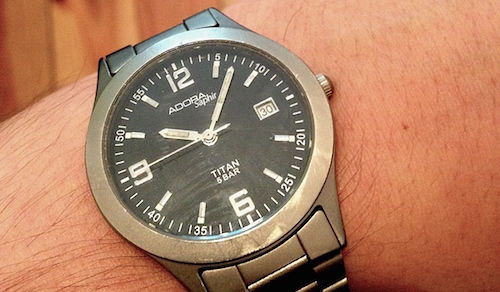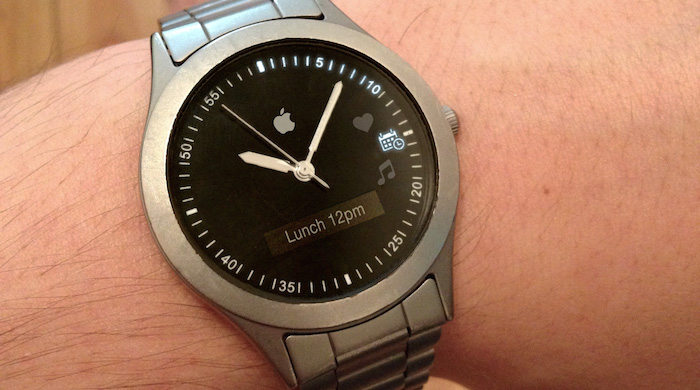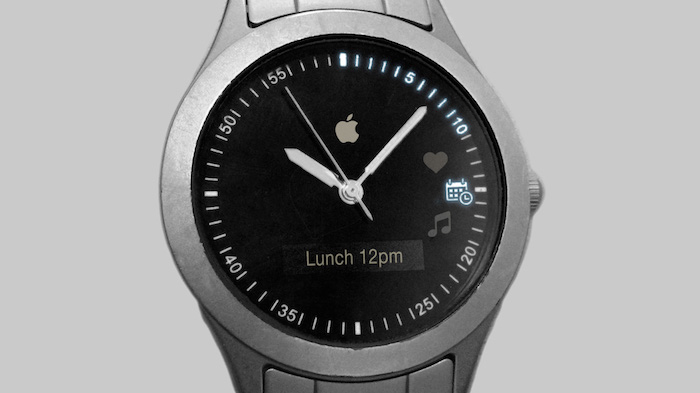Smart Watch
A few weeks ago I started wearing my good old wristwatch again. It’s a cheap analog metal watch, but with a sapphire screen, which appears to be all the rage these days.

There is one thing that watches do incredibly well: tell the time. I can always tell the time at a glance – without touching my wrist – and I virtually never have to worry about the battery running out or my watch failing me otherwise.
If Apple’s rumored upcoming wearable is a watch (and this is not entirely certain), it must not be worse at fulfilling that primary purpose than any other simple watch, mine included.
The smart watches currently on the market are crippled by their humongous size and embarrassing battery life, mostly because of their big displays. LCD displays make for great multimedia experiences, but a very bad watch experience. Traditional watches have none of these problems. Their digits are always visible and the battery lasts for years. I propose that a great smart watch (with the current technical constraints, at least) should not have a screen as it’s primary interface.

So, how would one go about making a normal wristwatch “smart”? If a watch is all about telling the time, then that aspect should first and foremost be enhanced. Most often when I look at my watch, I need to know the time because of some context. For example, I might have an upcoming appointment that I don’t want to be late for. An augmented watch should sync my calendar events from my iPhone via bluetooth (which uses very little power and component space) and show me when my next appointment will be in relation to the current time.
But how would this theoretical watch display such information? The answer can, I believe, be found in – of all things – car dashboards.

Premium car dashboards are awesomely designed analog interfaces – and many get by with nary a display.1 They use back lit cutouts of meaningful symbols to signal state to the driver – without distracting or presenting superfluous interactivity. That is how a smart watch should work.
The time of an event could be signaled by LEDs around the watch face lighting up.2 A small supplementary screen would only be useful to supply additional information like the description and place of a calendar event.3

It has been questioned whether Apple, a tech company, could design a traditional watch that fashionable people would want to buy. But it has already been done. The Withings Activité is a beautiful swiss timepiece with bluetooth and a step counter, made by a company that usually does fitness gadgets. If the NYT is right, Apple is planning to do something similar.
Speaking of steps: the rumor mill has it that a theoretical Apple wearable would sport several sensors that provide health data to the upcoming Health app. I find this plausible since the Activité proves that such sensors have no significant impact on battery life4 and can be synced via bluetooth. The watch itself does not necessarily need to have an interface to this data, but a step counter on the watch could prove useful.5

Of course I could be wrong and the eventual “iWatch” will have everything from a touch screen and LTE to a QWERTY keyboard.6 Or it could turn out to be a ring or something else entirely. We’ll know more come September 9th.
-
Admittedly, the future of car dashboards appears to be fully digital displays replacing the analog instruments of the olden days. This makes sense because a car obviously does not have the same power constraints as a wearable device. ↩
-
Similar to the cruise control speed indicator around the speedometer on current BMW dashboards. ↩
-
A small screen for text could work with E-Ink technology which requires little power and is very readable, even in direct sunlight. The smart watch does not need animation or color – only crisp, beautiful typography. ↩
-
Well, mostly. The Activité is not yet available to buy, but the website states that the watches button cell lasts “a full year”. ↩
-
This could be done with a small dial like on the Activité or with a seperate mode that displays the step count on the small display. Modes could be toggled via a small wheel at the side of the watch. ↩
-
Seriously, Samsung? ↩